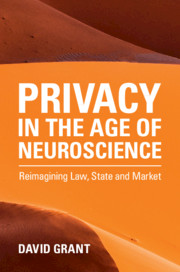Book contents
- Privacy in the Age of Neuroscience
- Privacy in the Age of Neuroscience
- Copyright page
- Contents
- Acknowledgements
- 1 Introduction
- Part I Privacy
- 2 Privacy, Neuroscience and Algorithms
- 3 The Frailty of Privacy Theory
- 4 Privacy as the History of Normalisation
- 5 Privacy, Its Values and Technology
- 6 A New Sense of Privacy
- Part II Regulation
- Bibliography
- Index
6 - A New Sense of Privacy
from Part I - Privacy
Published online by Cambridge University Press: 09 April 2021
- Privacy in the Age of Neuroscience
- Privacy in the Age of Neuroscience
- Copyright page
- Contents
- Acknowledgements
- 1 Introduction
- Part I Privacy
- 2 Privacy, Neuroscience and Algorithms
- 3 The Frailty of Privacy Theory
- 4 Privacy as the History of Normalisation
- 5 Privacy, Its Values and Technology
- 6 A New Sense of Privacy
- Part II Regulation
- Bibliography
- Index
Summary
A valid new sense of privacy would need to be founded on the principles of the existential, respectful self-responsibility of all individuals and the promotion of which would need to be complemented by a reimagined State, Market and technological design principles. This will allow the embrace, not the denial, of the value of technological development, especially in neuroscience. In this context, each individual would have an evolving personal technology strategy with progressive/enhancement and conservative/protection elements. From that, respectful self-responsibility would require both sharing information and acquiring it, all typically under the individual’s control, including through data and algorithms that are designed and applied under their direction. The initiatives undertaken by the IEEE and MyData are moves in the right direction, but they remain prey to mythological interpretation. The principles of this new sense of privacy are then tested by application to standard and well-known privacy dilemmas, including on case law.
Keywords
- Type
- Chapter
- Information
- Privacy in the Age of NeuroscienceReimagining Law, State and Market, pp. 175 - 196Publisher: Cambridge University PressPrint publication year: 2021

